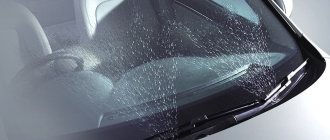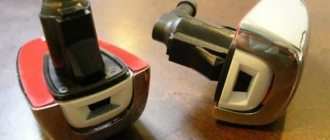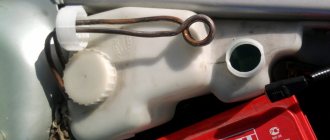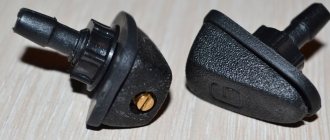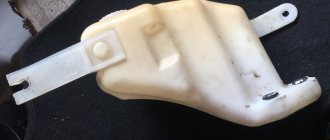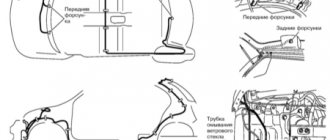Hi all! Our series of purely winter problems on cars continues. Today we’ll talk about how you can organize the heating of washer nozzles with your own hands.
In fact, the question is quite relevant. From the previous material you could learn what to do if the windshield washer nozzles are frozen and how to get out of this situation. But repeating such manipulations every time is not always convenient and simply physically possible. It is also worth remembering how to drain the water from the washer reservoir.
To avoid problems with washing the windshield, some modification is needed. How to make sure that the problem does not recur in the future, in our material today.
How to choose heated windshield washer nozzles
Installing heated nozzles instead of conventional ones does not cause any particular difficulties, as does making a heated washer reservoir with your own hands. Most nozzles, regardless of the method of spraying liquid, are universal and suitable for any car with a round seat. If the car has a rectangular seat, then you will have to look for injectors of this type. When choosing heated windshield washer nozzles, you must carefully check their condition. Often, various fakes are sold under the brand names of popular brands, in which a low-power resistor is used instead of a wire heating element. Therefore, buy them only in trusted stores.
The cost of such nozzles from an unknown manufacturer is from 700 rubles per set. Injectors from well-known manufacturers with a reliable reputation will cost 1-2 thousand rubles. Original injectors cost 2-3 thousand rubles apiece.
Some car owners buy heated injectors at auto repair yards, citing the fact that they are cheaper there. But the quality of such nozzles is unknown, so no one knows how they will work in winter. Don't skimp on the safety of your car. By spending the extra thousand on quality injectors, you will avoid serious problems in winter. The most reliable and efficient injectors are those from partner companies of well-known automakers.
At the same time, a heated injector from GAZ or AvtoVAZ and their partners is 2-3 times better and more reliable than a foreign one, the manufacturer of which is unknown. Therefore, Russian heated windshield washer nozzles often turn out to be much better than products for “modern foreign cars”, the manufacturer of which is unknown.
If you buy a heated windshield washer nozzle from a reputable manufacturer, keep in mind that these products must be supplied in individual packaging. The nozzle must have the manufacturer's name corresponding to what is written on the packaging.
Inspect the packaging carefully. Uneven edges and unclear patterns are signs of a fake. Ask the seller to show you the box in which he received the injectors. The manufacturer's name on the box and individual packaging must be the same. Carefully inspect the injector body. The presence of burrs or irregularities indicates that this is a fake. Use a needle to move the jets in different directions. They should turn with little resistance. If you have to press so hard to turn them that the needle bends even a little, you have a fake. If the jets turn without effort, it's a fake.
New injectors
If old sprayers do not want to work properly in winter, then it’s time to send them to the landfill. Or sell it as used spare parts.
In any case, when the washer keeps causing you problems, it needs to be replaced.
An excellent solution would be universal heated nozzles. These items fit a variety of vehicle makes and models. The assortment is impressive, that is, there should definitely not be any problems with selecting one specifically for your vehicle. The only problem is that the old system has to be dismantled and a new one installed in its place. Most kits provide detailed installation instructions. If you follow the rules and observe safety precautions, you won’t have to wait long for results.
The issue may be cost. Still, it is more expensive than buying a thermistor.
But the operating efficiency of nozzles equipped with heating is much higher. It is safer and more aesthetically pleasing. Moreover, new jets may have an attractive design that compares favorably with previous products.
It's up to you to decide anyway.
Principle of operation
Injectors require a constant source of heat to operate properly at low temperatures. Some vehicles are equipped with a heated windshield washer system, but most vehicles still use conventional jets.
Machines without additional equipment have an excellent source of heat - the engine. With its help, you can provide the nozzles with hot air and prevent the liquid from freezing. All you need to do is bring it to the injectors. It is worth noting that this method is only suitable for those cars whose jets are installed directly on the hood.
Operation of the check valve in the washer system
Not all hydraulic designs of glass cleaners have a check valve in their design. The presence of such a part allows the liquid to remain in the hoses without flowing back into the tank. The convenience is that when the pump is turned on, the water supply is carried out without delay and the wipers do not scrape the dry glass.
Check valve
This valve has a spring-loaded ball inside. It is this that blocks the passage of the “anti-freeze” back when there is no pressure from the pump in the system. If this element is not installed, then an electronic delay for the start of the wipers will need to be built into the circuit.
You can install the valve on any foreign car. Both European and Asian parts are suitable. Some daredevils even came up with the idea of installing valves from aquarium compressors into this circuit.
Recommendations
Comments 4
Hmmm... Let me start with the fact that the heating on the injectors is not constantly on. It all depends on the configuration, options and settings. For example, on my car it turns on along with the heated glass. Further, initially the nozzle contains not a “heating element”, but a banal thermistor. This has been discussed several times both here and at ffclub. They even found analogues, in every store there are tons of radio parts and they cost pennies. Thermistor resistance directly depends on temperature: the higher the temperature, the higher the resistance. Thus, when a certain temperature is reached, the thermistor simply stops passing current, unlike conventional resistance. So a circuit with resistance is inherently dangerous (short circuit, melted wiring, fire), while a circuit with a thermistor is safe. You can choose any suitable 12V thermistor with a temperature of 50 degrees.
The injector heating ALWAYS works, at least in Rusfocus. There is even a clipping from Murzilka... you can find it on the same ffclub. If it works with a button, then something has already been done with it. Regarding the thermistor, I agree that it is safer, but only from the point of view that it does not always fry to the fullest, nothing should happen to the resistor that I installed, in the worst case, it will simply fail. everything is insulated there well, after all, there is a fuse for heating, I think if the resistor blows, then it will die the death of the brave))) And it doesn’t heat up that much, without the case I just tested it for 10-15 minutes, all this time I could easily put my hand on it, it was warm. As a temporary solution, it is quite an effective method, although not temporary, too, many people have done it based on reviews from the forum...
To be honest, I was surprised, I didn’t know that the heating works all the time, but regarding the replacement, not so long ago someone had a blog entry about the fact that they had remodeled and installed heating from the Volga.
Exactly all the time, that’s what the engineers were thinking, it’s not clear.
Source: www.drive2.com
Heating the windshield washer on your own, or what kind of “collective farm” we live in
It’s already good if in cold weather the liquid poured into the windshield washer reservoir does not turn into ice. And it would be even better if this liquid did not thicken as it gets colder, which, unfortunately, is typical for “anti-freeze” products. And having become viscous, they are poorly sprayed by nozzles, and in addition to the quality of the spray, the range of action of the nozzles also suffers, which is one of many other problems of winter operation.
In addition, the supply of thickened “anti-freeze” from the tank to the glass creates additional load on the windshield washer pump, and this affects its reliability and can cause premature failure of the pump. It is no coincidence that windshield washer pumps constantly appear in the list of components that “delight” owners of cars of various brands with malfunctions.
However, a very serious problem awaits the driver who sets off on the road in a car where the “anti-freeze” in the washer reservoir became ice before the ambient temperature dropped to the value indicated on the label of the container in which the liquid was purchased. When there is nothing to pour on the glass, the wipers only smear the dirt adhering to it in front of the driver’s eyes, which makes the trip unsafe both for the driver and his passengers, as well as for other road users.
There is a risk of buying washer fluid with a freezing temperature higher than that stated by the manufacturer. We were convinced of this during household tests of liquids purchased in retail trade, and described it in the articles “Kitchen gatherings with a glass of “anti-freeze” and “Testing “anti-freeze”.
The experience of operating vehicles equipped with standard heating of the fluid in the washer reservoir suggests that there is a way out. And the same experience says that if there is heating, you can not only use products with a freezing temperature higher than the thermometer can drop without fear of freezing, but also, in order to save money, you can even dilute the “anti-freeze” with water.
It’s a pity that there are much fewer models with standard heating for the windshield washer than cars in which the manufacturer chose to save money on this useful option for winter operating conditions. But this situation opens up an uncultivated field for craftsmen looking to use their talents in the field of eliminating the shortcomings of manufacturers.
However, things didn’t come to the point of reinventing the wheel. And although non-standard heating of windshield washer fluid is made from scrap materials and with your own hands, which is why each such product is unique in its own way, most of them repeat the principle on which factory devices operate.
The principle is simple. Liquid from the engine cooling system is used as a coolant for heating the “anti-freeze”, the temperature of which, after the engine has fully warmed up, exceeds 80 degrees. All that remains is to build a coil from a hollow tube, or in the simplest case, bend a loop, modify the washer reservoir to accommodate what skillful hands turned the tube into, and use flexible hoses to connect the device to the engine cooling system. Some of the “do-it-yourselfers” completely exclude metal coils or loops from this scheme, and immediately pass a flexible hose through the tank, citing the fact that the deterioration of heat transfer through the hose material affects only in the first minutes after starting the engine, but the elimination of metal parts simplifies and reduces the cost of construction.
Where to connect the device to the engine cooling system is selected based on the location of the washer reservoir in the engine compartment and the proximity to it of suitable places for connection in the cooling system. Whether connecting to the supply or return of the interior heater is considered optimal, opinions are divided. It is advocated by craftsmen who believe that heating in the washer reservoir in the summer is harmful, and turning off the heater in the summer will also turn off the circulation of antifreeze through the heating. Other “Kulibins” are confident that not only is there nothing wrong with this, but there is even benefit, because, as you know, hot water cleans better than cold water, and they back up their confidence with personal experience in using heating. We note that the operation of standard anti-freeze heating is regulated by thermostats, so the first ones are most likely right.
Those who do not want to burden themselves with making coils, searching for hoses of the required diameter and other parts go to install factory heating from cars where it is used normally to cars where this “bells and whistles” are not provided by the manufacturer.
Again, demand always gives rise to supply, as a result of which the factory production of a useful device for winter use was mastered, not only flow-through, but also electric heating. True, in order to start serial production of heating units, the demand must be massive, and in a country where, due to climatic and road conditions, as well as the risk of buying under the guise of “anti-freeze”, you don’t understand what it really is, mass-produced cars suffer emblems of the Volga Automobile Plant.
However, as in the case of reinstalling a branded factory heating system in a car that never had one, for skillful hands, installing a heated washer reservoir for a VAZ in a car of another brand is not an insurmountable obstacle. According to those who have tried it, we note an interesting fact: the manufacturer of the factory heating promises that up to 5 degrees below zero, ordinary water can be used as a washer fluid.
Other methods of heating the “anti-freeze” are also possible. Of these, for some reason, the greatest doubts among the “homemade” people themselves, as well as among forum theorists, are caused by attempts to introduce heating using electric heating devices. But what else worries users who would not mind seeing heated windshield washer fluid in their car, but are not sure whether it will do more good than harm?
The main question is what effect does washing with hot liquid have on the windshield, will it one day burst? This is a tricky question, because it calls into question not only the very idea of heating, but also the sanity of those who have already installed it on their car. Perhaps that is why the fact that this happened to someone is kept silent in discussions on specialized forums. However, if the glass had cracked or become cloudy, then the factory production of heating units would have burned out soon after its organization, and it is already 20 years old.
But there is no shortage of stories that it is not at all necessary to wait until the glass warms up from blowing air from the stove, but you can water it with heated liquid, even when it is covered with a crust of ice, and the wipers are frozen to it. On the contrary, this saves the owner from the need to remove frost from the glass with a scraper and wait for the wiper blades to freeze off the glass heated by air from the stove.
In response to hesitation about the advisability of heating the “anti-freeze” in the tank, if it can freeze in the nozzles and the tubes supplying them, people who have tested the effectiveness of the devices in practice assure that if you do not abuse the dilution of the liquid with water, then this rarely happens. Therefore, the question comes down to what you want to get: the opportunity to use tap water instead of buying an “anti-freeze”, or you need insurance against the strong thickening of the “anti-freeze” and the risk of its complete freezing. If the first is a priority, then it is necessary to ensure that the liquid from the pipes and injectors, after stopping the car in a parking lot, has time to drain back into the tank.
In the second case, according to users, the injectors usually freeze only on the outside and are easily penetrated by heated liquid. If the “anti-freeze” becomes ice in the tank, then in the presence of heating, as practitioners assure, it will turn into liquid within a maximum of 10 minutes after starting the engine.
In fact, the only negative aspect in user reviews is that warm liquid, once on the glass, steams. The lower the ambient temperature, the higher the temperature of the liquid, the stronger the evaporation. There is not a word about the fact that the brushes can freeze, causing the “janitors” to stop coping with their duties, and about other shortcomings.
It's up to you to decide what to believe and what not, as well as evaluate the usefulness of heating. And there is no doubt that the assessment will be different, because everyone sees the world from the height of their own bell tower. Discussions on the forums confirm this perfectly. For those who travel a lot and spend just as much on purchasing windshield washer fluid, heating is interesting, but for those who get by with one or two bottles of “anti-freeze” in the winter, building a heating system on their own causes bewilderment, why bother with a garden, and surprise at how He lives on a “collective farm”.
Sergey BOYARSKIKH Photos by the author and from open sources ABW.BY
Our
Why do windshield washer nozzles freeze?
Quite often, at low temperatures, the windshield washer system does not work due to freezing of the nozzles. First of all, this is relevant for fan nozzles, since the cross-sections of their holes are very small. Theoretically, if you use a special antifreeze liquid, then there should be no problems with crystallization at temperatures down to -30 °C. However, in practice, things are somewhat different; already at -10 °C the injectors stop working. Therefore, in cars that are equipped with fan-type jets, heated windshield washer nozzles are provided.
There are several reasons for freezing:
- A low-quality liquid begins to crystallize at a temperature higher than that established by technological standards.
- While driving, the temperature of the injectors is greatly reduced by the oncoming air flow.
- Anti-crystallization ingredients are highly volatile and evaporate quickly. Therefore, the liquid begins to freeze at temperatures above the established norm.
- When the engine is turned off, the fluid supply to the system stops and it flows back into the tank. However, some of the liquid in the form of drops remains in the nozzles. Alcohol or another analogue quickly evaporates, turning the “anti-freeze” into ordinary water, which begins to freeze at zero temperature.
How it works
In winter, the windshield washer often fails. This is largely due to the fact that ordinary water or special liquids, but of low quality, are poured into the tank.
As a result, the system does not work because the water freezes, turns into ice, and clogs the nozzle tubes, as well as the nozzles themselves.
Some motorists, in order to avoid such troubles, use antifreeze for windshield washer in winter. The same antifreeze that is designed to operate the engine cooling system. Yes, the freezing threshold for this composition is higher. But globally this does not solve the problem. The liquid often freezes inside the nozzle (nozzle), which can negatively affect the operation of the washer motor and damage the entire system. We definitely don't need this.
In order for injectors to operate correctly at low temperatures, they require a heat source.
In favor of modern cars, we can say that the problem has been largely solved. This was done by installing a special heating system. That is, special sprayers are used, with a heating system already provided by the automaker.
But this heating of the liquid is not found on all cars.
I think it’s not difficult to figure out how to check whether the injectors have heating for your specific car. If they are frozen in winter and the nozzles need to be cleaned and adjusted, then there is probably no heating there.
A similar problem occurs for many cars:
- Kia Rio;
- Ford Focus;
- Lada Vesta;
- Lada Kalina;
- VAZ 2114;
- VAZ 2105;
- Daewoo Nexia;
- Renault Logan;
- Lada Priora;
- VAZ 2110, etc.
Just because there is a problem doesn't mean it can't be solved.
There are several ways. Let's consider them separately.
Heated washer nozzles
In winter, many car owners think about the benefits of heated windshield washer nozzles. This issue arises especially acutely in the autumn-winter period, when the weather is unstable, warm weather can easily give way to frost, and sudden frosts are possible. During this period, many car owners, even if they use antifreeze windshield washer fluid, dilute it in order to save money.
It is the savings on “anti-freeze” and sudden cold weather that most often cause the injectors to freeze.
Using a thermistor
One of the most common homemade methods is to organize heating with a thermistor.
I can’t say what specific device characteristics are needed for a particular car.
But the point of using the device is as follows:
- you need to take a thermistor;
- cut off everything unnecessary from there;
- put heat shrink tubes on the wires;
- solder the wires to the thermistor;
- warm up the heat shrink;
- pour sealant onto the area where the thermoelement will be;
- carefully insert the thermistor there;
- add sealant as needed;
- wait until the sealant hardens completely.
Motorists note that with such re-equipment, good results can be achieved.
But the method is also recognized as an outright collective farm. A budget option, potentially effective. But it can hardly be called simple. Some people are simply afraid to make such modifications to the glass washer system. And I will understand them in many ways.
Why is injector heating necessary?
The main purpose of the device in question is to eliminate the possibility of liquid crystallization in the nozzles. High-quality heating not only preserves the functionality of the spray parts, but also prevents damage to the washer system mechanisms, including connecting hoses, booster pump, electric motor, etc. As a result of installing heated nozzles, the driver of the vehicle will be provided with excellent visibility in all weather conditions.
Heated washer nozzles
Another advantage of the presented device will be the constant heating of the washer fluid, which will allow you to quickly and better remove ice, dirt or snow. In addition, an increase in the temperature of the rubber blades directly affects their elasticity, thanks to which they cope with their functions more effectively without damaging or scratching the surface of the windshield.
Operating principle of injector heating
In modern cars, trouble-free operation of injector heating is based on the use of special resistors programmed to activate electric heating elements at a certain sub-zero outside temperature. Such microscopic devices are placed inside the nozzle, and their size and shape directly depend on the model of the windshield cleaning system. Power to the heating element can also be supplied autonomously, after the driver presses a certain button in the cabin, but most often it is automated and turns on together with the heated rear-view mirrors or windows.
The only thing you will have to tinker with is installing a strong mount for new spray products, which may be slightly larger than standard products.
How to choose washer nozzles
It is best to choose jets specifically for your car. If you compare the fan nozzles of the windshield washer of the VAZ 2114 and similar parts for a foreign car, they will be different. Of course, these differences are not critical and you can always customize the part for your car brand, but in this case the installation will be much more difficult.
Or you can purchase universal products that are suitable for different machines. These elements are considered to be injectors with numbers 30655605 and 7845009010. They are presented in the Volvo and Sang Yong catalogs. Both jets are absolutely identical with one difference - the Korean part will cost almost half as much as the Swedish counterpart. Otherwise, both products can be used as windshield washer nozzles for Ford, Mazda, Subaru, Daewoo and other models.
Another alternative option is offered by the Toyota concern, but when purchasing jets under catalog number 85381-AA042 from this manufacturer, it is worth considering that they are sold in 1 piece. Therefore, when placing an order online, you must add two items to your cart. After purchasing the products, you can install them yourself.
How does injector heating work?
In modern cars, heating of windshield washer nozzles is usually implemented by electrical heating based on chip resistors. Miniature heating elements are mounted inside the nozzles, the shape and size of which depend on the specific model. Power can be supplied to this mini-heating element automatically at a certain temperature when the glass and mirror heating system is turned on or when the washer system is turned on.
In some models, the injectors are heated using the engine cooling system (ECS). Heating of the windshield washer system can be realized in three ways: heating the reservoir, insulating the hoses and heating the nozzles themselves.
If your car does not have heated windshield washer nozzles, you can replace the conventional nozzles with new nozzles with standard heating. Connecting this system is quite simple and will not cause any problems. The only thing you might encounter is some additions to the mounting of the new injectors. Each specific car model has its own specific nuances. Let's consider, as an example, the device for heating the windshield washer nozzles of the VAZ-2110.
Do-it-yourself heating of injectors
You can independently arrange the heating of the windshield washer nozzles by electric heating or using SOD.
- Heating using current . To operate, you need to prepare 2 heating elements based on 4 chip resistors 1206 by 200 Ohms, connected in parallel. We make a cut in the plastic of the nozzles to a depth of 1.0 mm and a width of 5.0 mm. We insert the heater into this hole and fill it with epoxy resin. Similarly, we install the heating element for the second nozzle and connect it in series with the first.
The power consumption of this heating will be 0.75 W. Instead of chip resistors, you can use 150 Ohm 0.25 Watt resistors connected in series. In this case, the second resistor is mounted strictly above the nozzles. The power connection can be made to the rear window heating or to a separate button.
- Heating using SOD. In the VAZ-2110, the washer nozzles are installed on a frill, so they can be heated using antifreeze (antifreeze). To do this, you need to prepare a copper tube of about 15.0 cm. First, remove the steam outlet pipe from the stove at the junction with the expansion tank. We connect one end of the copper tube to the hose from the expansion tank. We connect the second end to the steam exhaust hose from the stove. In the lower part of the frill we make cutouts into which we insert the SOD hose. The copper tube must be placed directly under the nozzles.
Similarly, you can organize heating of windshield washer nozzles on VAZ cars up to the 10th series, for example, VAZ-2109 and so on. However, there is one caveat. In these cars, the windshield washer jets are installed on the hood. Therefore, they must first be moved to the air intake grilles. To do this, you need to buy or make mounting brackets. It is also recommended to replace conventional injectors with fan injectors, for example, from a VAZ-2110.
We insulate the windshield washer tubes
To insulate washer pipelines, you can use K-Flex or Flex tubes, which are usually used in air conditioning systems. You can also ensure heating of the windshield washer pipelines by running a tube, which is located behind the sound insulation under the frill, next to the steam exhaust hose of the stove. For example, by winding them together.
It should be noted right away that heating the windshield washer reservoir and tubes ensures normal operation of the washer nozzles at a temperature not lower than – 10 °C. At lower temperatures, freezing of the injectors cannot be avoided. Therefore, these heating options are recommended to be used in combination with heating the injectors.
Engine heating
see also
I think you all know how an engine works. During operation, the motor actively heats up.
And then motorists had an interesting idea. Why not use the heat generated by the internal combustion engine in the engine compartment for the benefit of the windshield washer. At the same time, this does not require any costs, plus the efficiency of this method is very high.
see also
The only problem. This method is not suitable for all cars. This is true for cars where the jets are located directly on the hood itself. Otherwise, using this method will not give any result.
But if you are one of the lucky ones, then you have to do the following:
- take a utility knife and a piece of heat-resistant insulating material;
- lift the hood and secure it;
- mark the areas under the hood above which the injectors are located;
- draw a circle or square at these points;
- Using a stationery knife, cut two holes;
- It’s unlikely that you don’t have any insulation on the hood, but just bare metal;
- insulation is fixed around the perimeter of the holes;
- This covers the cut areas.
This creates a system for natural heating of the jets of the windshield washer unit.
The only thing left for you to do is to check the operation of your update in real test mode.
To do this, you need to close the hood, start the engine and let it warm up to operating temperature. Now get out of the car and touch the metal of the hood around the nozzles. If you feel warm, then everything works great. The injectors will definitely not freeze.
What are the advantages
See also
Yes, when compared with the installation of new washers equipped with heating, even the option with natural heating from the engine loses in terms of aesthetics.
But the considered method has its obvious advantages. Namely:
- low cost, since you don’t have to pay anything to make a couple of holes, and the insulation can be found in the garage;
- reliability of heating, since nothing will depend on the electrics, unlike heated washers;
- there is no need to make any changes to the car's electrical system;
- absence of any external changes, since traces of modification remain on the back of the hood.
By using natural heating, you save time and money and have an effective way to combat frozen windshield washer nozzles.
Whether to use this method or not is up to each individual. How do you solve the problem of freezing injectors? Share your experience.
Subscribe, leave comments, ask questions and tell your friends about us!
How to buy a passenger trailer cheaper: life hack, practical tips
I think you all know how an engine works. During operation, the motor actively heats up.
And then motorists had an interesting idea. Why not use the heat generated by the internal combustion engine in the engine compartment for the benefit of the windshield washer. At the same time, this does not require any costs, plus the efficiency of this method is very high.
How to adjust washer jets
No specialized equipment or special skills are required to adjust the nozzles. All you need is a regular needle or pin. In order to figure out how to adjust the windshield washer nozzles, it is enough to understand that they have a spherical shape and rotate freely inside the plastic housing. So it's simple:
- Feel free to insert the pin into the nozzle and begin to turn it in the direction you need.
- If the liquid hits the glass too low, then twist the pin upward.
- If the jet hits very hard, this can also be corrected with a needle.
- On foreign cars, the injectors have 3 jets, which are best adjusted differently. The extreme ones should be at the lowest points, as they hit the sides of the car. It is better to direct the middle ones to the central part of the windshield, and the remaining central jets are better to direct to the upper part of the glass.
You can also clean the washer jets yourself.
How to clean washer nozzles
If the jets begin to work incorrectly, then most often the problem can be solved by cleaning these elements from contaminants. Before cleaning the windshield washer nozzles, prepare:
- pin or sewing needle;
- compressor;
- large volume syringe;
- soap and water.
Before work, it is recommended to check the level of cleaning fluid in the tank, since the jets may not work due to a missing washer. After this, you need to disconnect the washer nozzles from the hoses and slightly press on them until they rise.
- Wash each nozzle in soapy water.
- Connect the compressor, turn on the blower and process the nozzle under high pressure.
- If you don’t have a compressor at hand, you can use a syringe into which you need to draw water.
- Clean the holes using a regular needle or pin.
- Insert the syringe into the nozzle and start flushing.
Of course, the compressor will be much more effective, but if the nozzles are severely clogged and do not allow liquid to flow, then with the help of improvised means you can at least temporarily solve the problem.
Another way is to leave the jets overnight in a soapy solution, and in the morning try to reuse the syringe or compressor. This will be useful in case of particularly severe old contamination.
Causes of injector freezing
Currently, car washer nozzles freeze for the following main reasons:
- Poor quality liquid has been poured into the tank;
- Draining of the cleaning solution back into the container;
- Decrease in air temperature near the spray elements.
In addition to the functional operation of the nozzles, as well as all elements of the spray system, only proven windshield cleaning fluid should be used, which does not freeze even at abnormally low outside temperatures.
In addition, after turning off the engine, the washer gradually flows back into the container, and some of the liquid inevitably crystallizes.
This most often becomes the main reason for injector failure.
